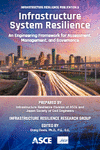Chapter 3
Outcomes of the Infrastructure Resilience Framework
Publication: Infrastructure System Resilience: An Engineering Framework for Assessment, Management, and Governance
Abstract
Outcomes of the infrastructure resilience framework include policy formulation, assessment of social and economic losses, and the economics of resilience. This chapter discusses the key elements of governance and management, the outcomes of the infrastructure resilience framework and tools. Policy is a course or principle of actions to create resilient systems adopted at the governmental and regulatory level or within the corporate or system organizational level. Social and economic losses include all direct and higher order (indirect) potential impacts to communities resulting from infrastructure system damage and service losses. The economics of resilience informs decisions relating to enhancing infrastructure system resilience and addresses the question of how much should be invested at the present and throughout the system's life to reduce consequences of failure and resulting losses in a cost-effective manner using principles of micro-economics. Tools useful for assessing, managing, and governing infrastructure resilience are identified.
Get full access to this article
View all available purchase options and get full access to this chapter.
References
Ayyub, B. M. 2014. Risk analysis in engineering and economics. 2nd ed. Boca Raton, FL: Chapman & Hall/CRC Press.
Cutler, H., M. Shields, D. Tavani, and S. Zahran. 2016. “Integrating engineering outputs from natural disaster models into a dynamic spatial computable general equilibrium model of Centerville.” Sustainable Resilient Infrastruct. 1 (3–4): 169–187.
Davis, C., B. Ayyub, S. McNeil, K. Kobayashi, et al. 2022. “Infrastructure resilience: A framework for assessment, governance and management.” In Proc., 4th Global Summit of Research Institutes for Disaster Risk Reduction, Increasing the Effectiveness and Relevance of Our Institutes, 127–155. Singapore: Springer. Accessed March 19, 2023. https://www.springerprofessional.de/en/proceedings-of-the-4th-global-summit-of-research-institutes-for-/23775482.
FEMA (Federal Emergency Management Agency). 2018. Continuity guidance circular. FEMA National Continuity Programs. Washington, DC: FEMA.
FEMA. 2023. National incident management system. Washington, DC: FEMA.
FEMA-NIST (National Institute of Standards and Technology). 2021. Recommended options for improving the built environment for post-earthquake reoccupancy and functional recovery time. FEMA P-2090/NIST SP-1254. Prepared by Applied Technology Council. Washington, DC: FEMA.
Gilbert, S., and B. M. Ayyub. 2016. “Models for the Economics of Resilience.” ASCE-ASME J. Risk Uncertainty Eng. Syst. Part A: Civ. Eng. 2 (4): 04016003.
Gilbert, S. W., D. T. Butry, J. F. Helgeson, and R. E. Chapman. 2015. Community resilience economic decision guide for buildings and infrastructure systems. NIST SP 1197. Gaithersburg, MD: National Institute of Standards and Technology.
Kajitani, Y., S. Chang, and H. Tatano. 2013. “Economic impacts of the 2011 Tohoku-Oki earthquake and tsunami.” Earthquake Spectra 29 (S1): S457–S478.
Kajitani, Y., and H. Tatano. 2009. “Estimation of lifeline resilience factors based on surveys of Japanese industries.” Earthquake Spectra 25 (4): 755–776.
Kajitani, Y., and H. Tatano. 2018. “Applicability of a spatial computable general equilibrium model to assess the short-term economic impact of natural disasters.” Econ. Syst. Res. 30 (3): 289–312.
May, P., and C. Koski. 2013. “Addressing public risks: Extreme events and critical infrastructures.” Rev. Policy Res. Policy Stud. Organ. 30 (2): 139–159.
McNeil, S., Y. Liu, and A. S. Ramirez-Villamizar. 2019. “Infrastructure resilience: From concept to performance to decisions.” In Bituminous mixtures and pavements VII, edited by A. F. Nikolaides and E. Manthos, 490–498. Boca Raton, FL: CRC Press.
Multihazard Mitigation Council. 2018. Natural hazard mitigation saves: 2018 Interim report. Washington, DC: National Institute of Building Sciences.
Mysiak, J., and A. Markandya. 2015. “Economic costs of droughts.” XEROCHORE Working Package 2 Brief. Brussels, Belgium: European Commission. Accessed April 21, 2019. https://www.researchgate.net/publication/267934571_ECONOMIC_COSTS_OF_DROUGHTS.
New Zealand Legislation. 2011. Canterbury earthquake recovery act 2011. New Zealand: Parliamentary Council Office.
Rose, A. 2004. “Economic principles, issues, and research priorities in hazard loss estimation.” In Modeling spatial and economic impacts of disasters. Advances in spatial science, edited by Y. Okuyama and S. E. Chang. Berlin: Springer.
Rose, A. 2007. “Economic resilience to natural and man-made disasters: Multidisciplinary origins and contextual dimensions.” Environ. Hazards 7 (4): 383.
Rose, A. 2009. “Economic resilience to disasters.” Community and Regional Resilience Institute, CARRI Research Rep. 8. Published Articles and Papers, Paper 75. Accessed March 19, 2023. https://text2fa.ir/wp-content/uploads/Text2fa.ir-Economic-Resilience-to-Disasters-1.pdf.
Rose, A. 2016. “Benefit-cost analysis of economic resilience actions.” In Oxford research encyclopedia of natural hazard science, edited by S. Cutter. New York: Oxford University Press.
Rose, A., S.-Y. Liao, and A. Bonneau. 2011. “Regional economic impacts of a Verdugo scenario earthquake disruption of Los Angeles water supplies: A computable general equilibrium analysis.” Earthquake Spectra 27 (3): 881–906.
United Nations. 2016. “The infrastructure–inequality–resilience nexus.” In Global sustainability development report. New York: United Nations.
Information & Authors
Information
Published In
Infrastructure System Resilience: An Engineering Framework for Assessment, Management, and Governance
Pages: 35 - 41
Editor: Craig Davis, Ph.D., P.E., G.E.
ISBN (Online): 978-0-7844-8508-8
Copyright
© 2023 American Society of Civil Engineers.
History
Published online: Sep 25, 2023
ASCE Technical Topics:
Authors
Metrics & Citations
Metrics
Citations
Download citation
If you have the appropriate software installed, you can download article citation data to the citation manager of your choice. Simply select your manager software from the list below and click Download.
